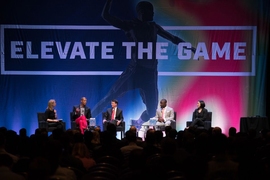Ben Shields is a self-avowed sports fanatic. But it’s clear that his interest spans beyond mere appreciation for the spectacle and the competition itself. “I’ve had the privilege to research and write about the sports industry since 2003,” says Shields. The statement, while wholly accurate and sincere, belies the fact that Shields has made, and continues to make, essential contributions to our understanding of the ever-changing landscapes of social media technologies, data analytics, and audience behavior. His explorations of the inner workings of sports and entertainment, through the lens of technology, allow him to draw conclusions that are relevant far beyond what would appear at first glance to be the scope of those industries.
Shields joined the MIT Sloan School of Management as a lecturer in managerial communication in 2014. His courses, 15.280 (Communication for Leaders) and 15.281 (Advanced Leadership Communication), take on critical importance in the complex, technologically-connected world in which leaders operate. He has also developed a new course, 15.S10 (Social Media Management: Persuasion in Networked Culture), which equips students with the frameworks and best practices to maximize the persuasive power of social media platforms.
Shields has a wealth of practical experience to draw from. Prior to joining MIT Sloan, he served as the director of social media and marketing at ESPN. There, he realized the sports industry was on the cusp of a paradigm shift in terms of fan behavior, specifically how fans consumed and engaged with sports via social media. Shields describes this time, 2008-2009, as the early days of social media. As such, many businesses were unsure of how to adapt to the platforms. Shields, however, collaborated with colleagues across the enterprise to develop a strategy for the ESPN brand that maximized the business value of their social media outreach. In addition to revamping how ESPN communicated with its audience, he also designed and implemented marketing strategy for several ESPN brands and sub-brands, working on highly successful campaigns, including the “It’s Not Crazy, It’s Sports” campaign, which would eventually garner an Emmy Award.
Shields says, “Sports is a petri dish to research and better understand broader trends in business like technology adoption, media consumption, digital disruption on revenue models, and even disciplines like crisis management in the social media age.” Furthermore, he notes that fitness tracking technology is on the rise, which calls into question issues of data privacy. Shields cites the complexities of data collection with regard to the use of new biometric wearable technologies, which track the health and performance of players with rigorous efficiency. He acknowledges that data collection technologies are developing at a rate that policy is struggling to keep pace with. In that sense, the players and the teams find themselves in a nebulous space. Wearable technologies provide the potential for healthier players. But who owns the data? And at what point is individual privacy being encroached upon? These questions are debated daily in the sports industry, and are inextricably linked to the wider discussion around data collection and privacy that affects us all.
Shields also cites the unpredictability of the product (the teams themselves) as a particularly interesting area of investigation. Whereas in other industries there is relative certainty as to how a product will perform, with sports it is nearly impossible to predict what will happen during the game or as a result of that game. Shields illustrates the point by explaining that if we, the consumer, want to order a product from Amazon, we understand how the site works: Search functionality allows us to find the product we want, and our desired product will most likely arrive when expected. It’s predictable and consistent. Not so with sports: “Sports teams and leagues have to sell a product for which they cannot control its performance, which is why all the other elements of a sports organization become critical — the fan experience at the stadium and online, the ability of organizations to build brands that connect with fans, the ability for teams to understand what fans want from the experience and analyze that data to deliver those products and experiences — all to both foster stronger loyalty and generate additional revenue.” And, says Shields, the most successful sports teams, in terms of generating revenue, are innovators, operating as profitable businesses, regardless of what happens on the field. In other words, a winning team does not necessarily equate to success from a business standpoint. And if winning is to a certain extent beside the point, Shields’ research shows that these organizations provide models that other businesses can learn from.
With regard to his life at MIT, Shields is particularly proud to be involved in the MIT Sloan Sports Analytics Conference. Co-founded by Daryl Morey, Houston Rockets general manager and a Sloan alum, and Jessica Gelman, CEO of Kraft Analytics Group, SSAC is student run, and it has become the premier conference in the industry. “This conference is something I look forward to every single year. It is an extraordinary showcase of our students’ creativity, leadership, and work ethic.”
Most recently, Shields also took part in the December, 2016 MIT Industrial Liaison Program Consumer Dynamics Conference, where he presented on innovative best practices from the sports industry that are relevant to any consumer-driven enterprise. Shields explored topics including how media is changing consumer behavior, how data driven decision-making can help organizations generate more revenue, and the importance of brand building in a cluttered marketplace. He thinks exploring these issues through the lens of sports is exciting, even fun. However, he insists the idea is to understand how these trends in sports are applicable to other industries.
Shields has written three books. His first two are "The Sports Strategist: Developing Leaders for a High-Performance Industry" (Oxford University Press, 2015) and "The Elusive Fan: Reinventing Sports in a Crowded Marketplace" (McGraw-Hill, 2006). In January he released his third, "Social Media Management: Persuasion in Networked Culture" (Oxford University Press, 2017). “The question that I try to grapple with [in my new book] and offer a clear digestible framework for addressing is: How can organizations and leaders maximize the business value of social media?” Shields describes the work as a detour from his usual fare, in that it is not sports-focused. Indeed, one of his stated goals with his most recent work is to ensure that the next generation of executives and leaders understands how to best utilize social media to have a streamlined business platform and accomplish their goals. However, Shields through his research, writing, and teaching has demonstrated that best practices and lessons learned in the sports industry have far-reaching implications for other industries. So, in a sense, perhaps his Social Media Management course is less a departure than a logical extension of his body of work thus far.








